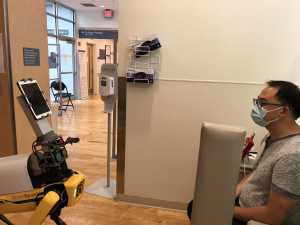
04 Mar Calling Dr. Spot: Robotic TeleDog Can Perform Key Hospital Tasks
MedicalResearch.com Interview with:

Dr. Traverso
Carlo Giovanni Traverso, MB, BChir, PhD
Associate Physician, Brigham and Women’s Hospital
Assistant Professor,

Dr. Chai
Peter R. Chai, MD, MMS
Emergency Medicine Physician and Medical Toxicologist
Harvard Medical School
Brigham and Women’s Hospital
Department of Medicine
 MedicalResearch.com: What is the background for this study? What are some of the functions that Dr. Spot can facilitate?
MedicalResearch.com: What is the background for this study? What are some of the functions that Dr. Spot can facilitate?
Response: During the COVID-19 pandemic, we wanted to consider innovative methods to provide additional social distance for physicians evaluating low acuity individuals who may have COVID-19 disease in the emergency department. While other health systems had instituted processes like evaluating patients from outside of emergency department rooms or calling patients to obtain a history, we considered the use of a mobile robotic system in collaboration with Boston Dynamics to provide telemedicine triage on an agile platform that could be navigated around a busy emergency department. Dr. Spot was built with a camera system to help an operator navigate it through an emergency department into a patient room where an on-board tablet would permit face-to-face triage and assessment of individuals.
 MedicalResearch.com: What are the main findings of patient acceptance and usefulness to the care providers?
MedicalResearch.com: What are the main findings of patient acceptance and usefulness to the care providers?
Response: We conducted a national survey to understand the potential tasks a robotic system could complete in a healthcare system in the setting of COVID-19. This showed that the general public was accepting of a robotic system like Dr. Spot to perform key hospital tasks like obtaining vital signs, providing assistance to patients and even performing tasks like swabs for COVID-19. We then conducted surveys of patients in the emergency department who were triaged and evaluated by Dr. Spot and we found a high amount of acceptability by patients to interacting with the robotic system. Furthermore, they considered their experience being evaluated by Dr. Spot equivalent to in-person physician/nurse triage.
MedicalResearch.com: What should readers take away from your report?
Response: This study found that patients and the general public are accepting of robotic systems to evaluate patients in the setting of the COVID-19 pandemic. This study should serve as a basis for future work that develops these and other robotic systems for management of patients in emergency departments, hospital settings and field hospitals or alternative care centers developed during the COVID-19 pandemic.
MedicalResearch.com: What recommendations do you have for future research as a result of this work?
Response: Robotic systems are feasible to deploy in hospital settings and physicians and other hospital staff can be trained to operate them. Patients are accepting of evaluations facilitated by robotic systems. This may help develop these platforms as ways in which to care for patients and perform key hospital tasks in the future.
Disclosures: The study was a collaboration between researchers at MIT, Brigham and Women’s Hospital and Boston Dynamics.
Citation:
Chai PR, Dadabhoy FZ, Huang H, et al. Assessment of the Acceptability and Feasibility of Using Mobile Robotic Systems for Patient Evaluation. JAMA Netw Open. 2021;4(3):e210667. doi:10.1001/jamanetworkopen.2021.0667
JOIN OUR EMAIL LIST
[mailpoet_form id="5"]We respect your privacy and will never share your details.
[last-modified]
The information on MedicalResearch.com is provided for educational purposes only, and is in no way intended to diagnose, cure, or treat any medical or other condition. Always seek the advice of your physician or other qualified health and ask your doctor any questions you may have regarding a medical condition. In addition to all other limitations and disclaimers in this agreement, service provider and its third party providers disclaim any liability or loss in connection with the content provided on this website.
Last Updated on March 4, 2021 by Marie Benz MD FAAD
